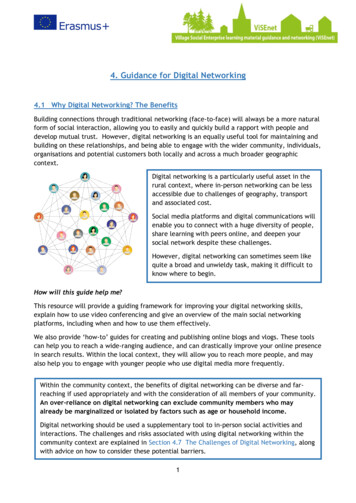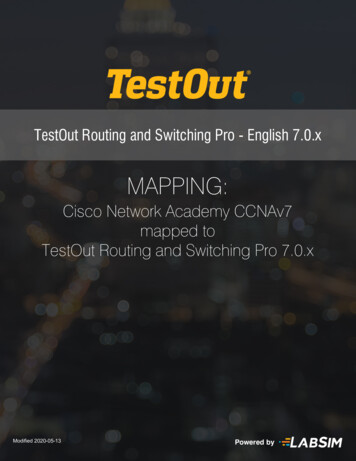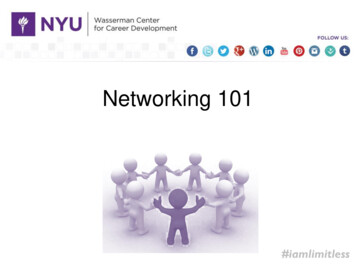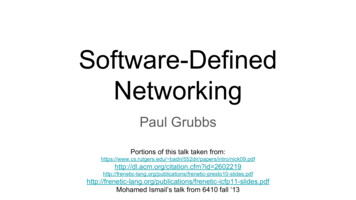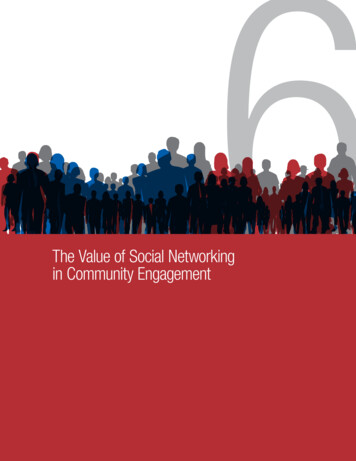
Transcription
The Value of Social Networkingin Community Engagement
Chapter 6The Value of Social Networking in CommunityEngagementAnn Dozier, PhD (Chair), Karen Hacker, MD, MPH, Mina Silberberg, PhD, Linda Ziegahn, PhDINTRODUCTIONCommunities are not made up of unrelated individuals or groups; rather, theyinclude “social networks” that comprise community groups or organizations,individuals, and the relations or “linkages” among them Social networksare crucial to every aspect of community engagement, from understandingthe community and its health issues to mobilizing the community for healthimprovement A growing literature is highlighting the role that individuals’social networks play in conditioning their health, and the emergence ofelectronic social media provides new ways to form and engage networks For these reasons, we devote an entire chapter to the role of social networksin community engagement, beginning with an overview of the topic andthen moving to a focused look at the new social media 151
WHAT ARE SOCIAL NETWORKS?As defined by Wasserman et al (1994), “A social network consists of a finiteset of actors and the relation or relations defined on them” (p 20) Any oneindividual can be part of multiple social networks, and the nature of thesenetworks and the individual’s connection to the networks can vary greatly For example, social networks are not necessarily rooted in traditional relationships, such as kinship or clan, but can develop out of geographic proximity,work relationships, or recreational activities Moreover, social networks canbe described and analyzed in terms of their diverse characteristics (e g , howmany people or organizations belong to a network, how well the membersof the network know each other, and how equal their relationships are) SOCIAL NETWORKS AND HEALTHSocial networks can be a key factor in determining how healthy a communityis For one thing, they can create social supports that provide a buffer againstthe stressors that damage health (House et al , 1998; Zilberberg,2011) Social networks may also have negative effects on health,Social networks can be a key however (Arthur, 2002; Cattell, 2001) Christakis et al (2007),factor in determining how healthy for example, found “clusters” of obesity within a network ofpeople studied over time Their longitudinal analysis suggesteda community is. that these clusters were not merely the result of like-mindedor similarly situated people forming ties with one another, butrather reflected the “spread” of obesity among people who were connectedto each other (Christakis et al , 2007) Although not everyone agrees on howsocial networks affect health (Cohen-Cole et al , 2008), they seem to play arole, together with culture, economics, and other factors, that is importantfor both individuals and communities (Pachucki et al , 2010) In New York City, for example, one group tailored its outreach and education programs on breast and cervical cancer by determining how differingcultural perspectives affected social networks They found that for the Latinopopulation, women’s relationships easily lent themselves to the helper role,but that access to and utilization of health care in this population weremediated by men Therefore, they included both genders in their intervention (Erwin et al , 2007) 152
Social networks can also play an important part in community healthimprovement because of their role in the “diffusion of innovation” — aconcept introduced in Chapter 1 — and in the generation of social capital,defined by Putnam (1995) as “features of social organization such as networks, norms, and social trust that facilitate coordination and cooperationfor mutual benefit” (p 66) A critical first step in engaging communitiesis identifying networks, such as faith communities, whose “social capital”can be employed in collective approaches to improving community health THE ROLE OF SOCIAL NETWORKS IN COMMUNITY ENGAGEMENTChapter 4 outlined four practice elements for development of a constituency(know the community, establish strategies, build networks, and mobilizecommunities) and used them to conceptualize the tasks of communityengagement (Hatcher et al , 2008) In this chapter, we will use these fourelements to describe the role and importance of social networks in community engagement Know CommunitiesLearning about a community, whether it is defined geographically or by acommon interest (for example, a health condition or disease) means knowing the community’s cultures and institutions, its capabilities and assets,and its health needs and challenges Typically, learning about a communityrequires a variety of approaches, including gathering existing data andgenerating new information, combining qualitative and quantitative data,and incorporating the perspectives of a broad spectrum of individuals,organizations, and groups Understanding a community’s social networks is essential because of theirpotential to affect population health Social networks can also provideaccess to a community and generate knowledge of its characteristics Forexample, traditional healers may be widely known within Hmong or Latinonetworks but unknown to those outside these social networks, includingthose working in health care institutions in the same community It is onlyby bridging to the relevant networks that health care workers can learnabout these traditional healers 153
Social network analysis (SNA) is a method that can be used to evaluatecommunity engagement and assess communities By providing a way ofdescribing the diversity of networks and a set of tools for visually representing and quantifying the characteristics of a network, SNA can help partnersunderstand a community’s networks and track how they grow and changeover time This methodology is discussed further in Chapter 7 Establish Positions and StrategiesSocial networks represent important groups of constituents in any community health planning initiative These groups can be engaged to providefeedback, identify priorities and opportunities, establish positions on issuesand approaches, and plan strategies for intervention Both obtaining knowledge about social networks and gathering knowledge from such networksare essential to the development of relevant strategies for health improvement In addition, social networks are a means of communication, creatinga platform for sharing and discussing potential positions and strategies Build and Sustain NetworksBuilding and sustaining networks of individuals and entities for communityhealth improvement or research includes establishing and maintaining communication channels, exchanging resources, and coordinating collaborativeactivities Existing social networks can be effective and efficient platformsfor efforts in community engagement if they reach people who are centralto these efforts and if their members share the goals of the engagementefforts Through the community engagement process, new networks canbe developed as well Mobilize ConstituenciesUltimately, partners and their constituencies must be mobilized to takethe actions that will lead to improved community health, and mobilizationmust be sustained through leadership, communication, and motivation Asdescribed earlier in this chapter, this is where the social capital embeddedin social networks is of the utmost importance Throughout the community154
engagement effort, relationships must be strengthened and new capacityfor collective action developed It is important to reach out and pull in keyopinion leaders and community stakeholders In one example of how this can work, a clinician-researcher at the Universityof California, Davis, used social networks to help reduce dog bites amongchildren After noticing that a large number of children were being seen fortreatment of dog bites, the investigator identified social networks such as dogowners, school crossing guards, and neighborhood associations and engagedthem in understanding the problem, defining workable solutions, and mobilizing the community to put these solutions into action (Pan et al , 2005) ELECTRONIC SOCIAL MEDIA AND COMMUNITY ENGAGEMENTIntroductionThe tools of electronic social media, such as Facebook and Twitter, can beused to track, support, create, and mobilize social networks; these toolshave significant potential to enhance community engagement efforts (Fine,2006) Social media venues have undergone a significant shift to greaterbidirectional or multidirectional communication in recent years (Bacon,2009), and thus these venues represent opportunities for health messagingthat have yet to be fully realized In addition, they provide new forums toraise issues, facilitate the exchange of ideas, and engage a larger community The Potential of Social MediaSocial media tools provide a newly emerging mechanism for engaging a largeand diverse group of participants, including individuals or groups that mightotherwise be hard to reach or to bring together, such as individuals with arare disease (Bacon, 2009; Fine, 2006) Social media also provide a forumfor discussion that has important differences from face-to-face interactions With social media, all participants have an opportunity to contribute tothe discussion, responses need not be immediate, and time can be taken toreview the thread of a discussion Social media also provide opportunitiesto reframe questions as the discussion evolves (Connor, 2009) 155
In addition, social media can generate a discussion archive that is useful forrevisiting opinions, information, and collective history Furthermore, the manner in which social media are used by the community in the initial stages ofengagement might be a barometer of the capacity to engage that communityand success in doing so, facilitating evaluation of community engagement Generally, depending on how groups communicate, a broader group of participants can be engaged using social media than through traditional means,facilitating the process of establishing collective positions and strategies Specifically, social media can provide a forum for interaction and discussionabout both draft and final position statements Clearly, social media alsoplay an important role in building and sustaining networks by facilitatingongoing communication, social exchange, and coordination of activities Moreover, these media can help build trust by providing venues in whichpartners can demonstrate transparency and openness Meeting agendas,minutes, handouts, and questions (and responses) can all be posted andviewed Finally, social media can be a tool for mobilizing organizations and community members and, even more important, social media can help sustainengagement and commitment Social media can also offer accessible sitesto provide information about a developing engagement, such as its purposeand goals and who is involved (Bacon, 2009; Connor, 2009) Cautions on the Use of Social MediaMany of the cautions about social media are similar to those for any community engagement activity (Bacon, 2009) For example, when appraisingface-to-face interactions, we ask, are the responses honest? Will people havethe time to participate? We need to ask those questions about the use ofsocial media, too However, use of social media raises additional concernsabout who is actually participating and whether they are who they representthemselves to be Building trust is essential for community engagement,and networking through social media alone is unlikely to achieve the levelof trust needed for collective action Rather than being seen as a substitutefor in-person interactions, social media may be better viewed as supplementary or complementary, particularly in the early stages of community156
engagement Furthermore, social media should not be regarded as aninexpensive alternative to the in-person building of relationships Like anycommunity engagement effort, use of social media for communication engagement will take time (Connor, 2009) Overall, it is important to understandthe modes of communication employed by the community of interest andthen use those modes Time is a particular concern for the person who plays the crucial role ofmoderating a social media forum It is the moderator’s job to demonstratethat someone is listening, keep the discussion developing, and recruit andretain members There are many ways in which an online community canbe undermined, and it is the moderator’s job to enforce the “rules of engagement ” Once established, a forum requires regular attention Given the paceof interactions in the social media environment, moderating a forum mayrequire visiting the site several times a day (Bacon, 2009) Recommendations about specific products have not been included in thischapter, because products continue to evolve Furthermore, although thediscussion addresses how social media can be used, the question of whetheror when it is appropriate to use specific social media is contingentupon the nature of the individual project, available resources,Given the resources necessary toand the appropriateness of the tool for the particular community Given the resources necessary to involve social media, it wouldinvolve social media, it would be abe a mistake to try to be “everywhere ” Engagement is an iteramistake to try to be “everywhere.”tive process; organizations should be selective, determine whichmedia (if any) the community of interest are already using, andask the community what approaches (if any) should be used and at whattime in the engagement process social media should be introduced Like alldecisions about community engagement strategies, decisions about the useof social media should be made by engaging the community CONCLUSIONSocial networks are an important tool for understanding a community andmobilizing it for health improvement New research literature has broughtincreased attention to the role that social networks can play in population157
health, and the growing use of community-engaged health promotion andresearch has brought to the fore the potential for social networks to support collective action for health improvement Moreover, the emergence ofelectronic social media has diversified the ways in which networks can beformed and engaged “Networking,” whether in person or electronically,is not the same as creating, sustaining, or engaging a community; if doneincorrectly, it can undermine rather than support collaborative efforts Theprinciples laid out in this primer must be applied to the use of social networks just as they should be to all engagement efforts 158
REFERENCESArthur T The role of social networks: a novel hypothesis to explain thephenomenon of racial disparity in kidney transplantation American Journalof Kidney Diseases 2002;40(4):678-681 Bacon J The art of community: building the new age of participation (theoryin practice) Sebastopol (CA): O’Reilly Media; 2009 Cattell V Poor people, poor places, and poor health: the mediating role of socialnetworks and social capital Social Science and Medicine 2001;52:1501-1516 Christakis NA, Fowler JH The spread of obesity in a large social networkover 32 years New England Journal of Medicine 2007;357(4):370-379 Cohen-Cole E, Fletcher JM Detecting implausible social network effects inacne, height, and headaches: longitudinal analysis BMJ 2008;337:a2533 Connor A 18 rules of community engagement: a guide for building relationshipsand connecting with customers online. Silicon Valley (CA): Happy About; 2009 Erwin DO, Johnson, VA, Trevino M, Duke K, Feliciano L, Jandorf L Acomparison of African American and Latina social networks as indicatorsfor culturally tailoring a breast and cervical cancer education intervention Cancer 2007;109(2 Suppl): 368-377 Fine A Igniting social change and the connected age. San Francisco: JosseyBass; 2006 Hatcher MT, Nicola RM Building constituencies for public health In: NovickLF, Morrow CB, Mays GP (editors) Public health administration: principles forpopulation-based management (2nd ed , pp 443-458) Sudbury (MA): Jonesand Bartlett; 2008 House JS, Umberson D, Landis K Structures and processes of social support Annual Review of Sociology 1998;14:293-318 Pachucki M, Breiger, R Cultural holes: beyond relationality in social networksand culture Annual Review of Sociology 2010;36:205-224 159
Pan RJ, Littlefield D, Valladolid SG, Tapping PJ, West DC Building healthiercommunities for children and families: applying asset-based communitydevelopment to community pediatrics Pediatrics 2005;115(4 Suppl):1185-1187 Putnam RD Bowling alone: America’s declining social capital Journal ofDemocracy 1995;6(1):65-78 Wasserman S, Faust K Social network analysis: methods and applications.Cambridge, United Kingdom: Cambridge University; 1994 Zilberberg MD The clinical research enterprise: time to change course?JAMA 2011;305(6):604-605 160
social networks play in conditioning their health, and the emergence of electronic social media provides new ways to form and engage networks For these reasons, we devote an entire chapter to the role of social networks in community engagement, beginning with an overview of the topic and then moving to a focused look at the new social media





